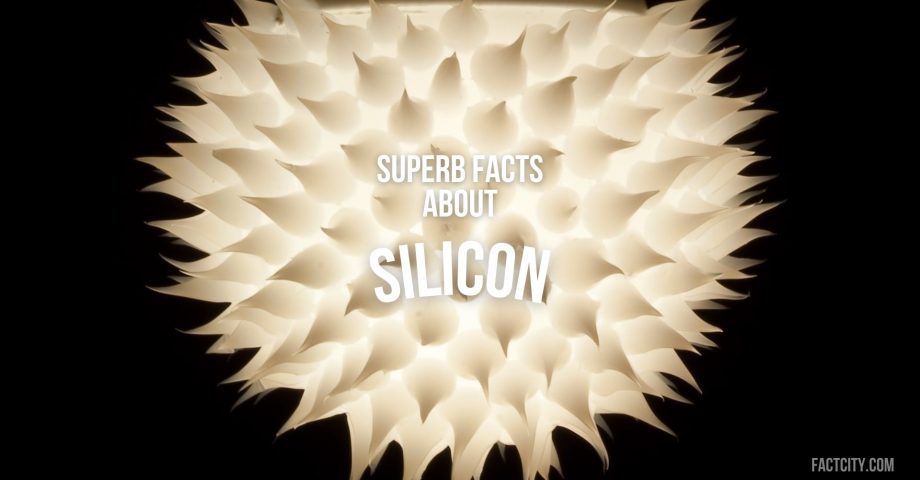11 Superb Facts about Silicon
Silicon may not be as well-known by the masses as oxygen or helium, but it is one of the most important elements on the planet. But why is this? What is silicon, and what do we use it for? You’ve probably heard of silicon chips and Silicon Valley – but here at Fact City, we go a bit deeper. Here are some fun facts about silicon to impress your science-following friends with.
1. It is represented by the symbol “Si.”
On the periodic table, silicon is represented by the chemical symbol “Si.” It’s easy to find with an atomic number of 14.
2. There’s huge stockpiles of silicon beneath us.
It is the second most abundant element we’;re aware of in the Earth’s crust, making up about 27.7% of the Earth’s crust by weight.
3. Silicon is known as a metalloid – it’s not technically a metal at all.
Technically speaking, silicon is a metalloid. This means that it has properties of both metals and nonmetals. It is a semiconductor, which is crucial in electronics – and explains why the element is used so much in the creation of chips and the construction of engineering elements.
![]()
4. Silicon dioxide is abundant in nature, too.
SiO2, or silicon dioxide, is the most common compound of silicon found in nature. However, it’s not in the air – but beneath our feet. It is the primary component of sand, quartz, and most rocks.
5. Silicon Valley got its name from the amount of Si being used in manufacturing in the area.
Many immediately associate the word “silicon” with Silicon Valley. Silicon Valley, based over in California, is one of the world’s leading innovation and tech hubs – it’s a hive for tech startups and household brands. It got its name due to the large number of silicon chip manufacturers and technology companies based there.
6. It is often used in glass manufacturing.
Silicon is commonly used in the production of glass and ceramics. This is due to its ability to withstand high temperatures and its contribution to its structural integrity.
7. Silicon is vital for the semiconductor industry.
Silicon wafers, in particular, are crucial for the semiconductor industry. This is due to the fact that they are used to manufacture computer chips, transistors, and other electronic components.
8. It is also used in solar panel manufacture.
Silicon is also a key material used in the production of solar cells. Silicon solar panels are widely used to convert sunlight into electricity. It’s complex stuff, but it certainly works!
9. Silicon is refractory and won’t melt unless it’s extremely hot.
Silicon is known as a refractory material. This means that it can withstand extremely high temperatures without ever melting. This makes silicon very valuable in the production of steel and other high-temperature applications. It’s unlikely you’ll ever see silicon melt unless you work in the steel industry!
Condensed polysilicic acid
10. The silicon transistor helped to bring technology home, and changed the way we do business.
The invention of the silicon transistor in the 1950s revolutionized the electronics industry! It even paved the way for the development of modern computers and electronic devices. Without silicon, you wouldn’t even be reading this article!
11. There’s a bit of silicon in all of us!
Believe it or not, silicon can indeed be found in our bodies! However, it only appears in small traces. It is believed to play a role in maintaining healthy bones and connective tissues. It’s not a good idea to ingest silicon, however!
FAQs about Silicon
Where is silicon found naturally?
Technically speaking, silicon is too reactive an element to be found in its pure form in nature. However, as mentioned above, it can be found combined with other elements in rocks, sand, soils, clays, etc.
Are silicone and silicon the same thing?
Silicon is a natural chemical element. On the other hand, silicone is a man-made polymer made from silicon.
Where is the most silicon found on Earth?
China is known for being the world’s largest producer of silicon, but naturally, you’ll find it in abundance in the Earth’s crust.
Further reading
https://factcity.com/tag/Science/
https://www.chemicool.com/elements/silicon.html
https://chem.libretexts.org/Bookshelves/Inorganic_Chemistry/Supplemental_Modules_and_Websites_(Inorganic_Chemistry)/Descriptive_Chemistry/Elements_Organized_by_Block/2_p-Block_Elements/Group_14%3A_The_Carbon_Family/Z014_Chemistry_of_Silicon_(Z14)
Do you know any interesting facts about silicon? Share them in the comments below!
This page was last modified on September 29, 2023. Suggest an edit









